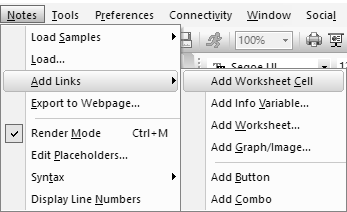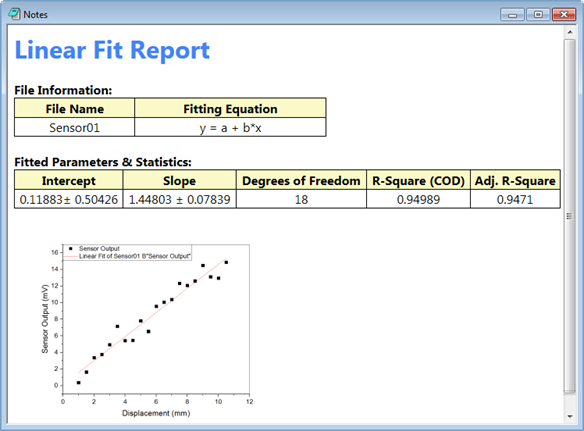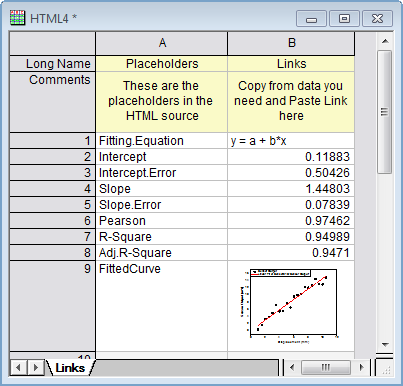2.3.2 HTML and Markdown ReportHTML-Report
From Origin 2019b, Notes window supports two modes: ordinary Edit Mode and Render Mode. When you edit a report according to HTML or Markdown syntax in Note Widows, you can show the report by render Mode. In the report, you can refer to Origin graph, image in matrix, analysis table and any worksheet cells. When the source changes, the linked in Notes window also get updated. This render mode makes it possible for Notes window to serve as an analysis report.
Switch to Render mode
The default mode of Notes window is text mode. To switch to Render mode, you can use one of these four methods:
- Select Notes: Render Mode in the menu
- Right-click on the Note window title, and select Render Mode
- Active Note Window, and press Ctrl + M hotkeys
- Run Labtalk script:
note.view=1;
| Notes: If you use Markdown syntax in the Notes Window, you must change Syntax to Markdown before changing to Render Mode.
|
Syntax in the Notes Winow
In Note widow, the edit mode default shows plain text as syntax option. When you edit by HTML or Markdown syntax, you can change the Syntax option. The HTML will shows the colored of the HTML syntax , while the Markdown syntax could help the Render Mode identify it is using Markdown syntax.
To switch to Syntax option, you can use these methods:
- Select Notes: Syntax: Text / Origin Rich Text / HTML / Markdown in the menu
- Right-click on the Note window title, and select Syntax: Text / Origin Rich Text / HTML / Markdown
- Run Labtalk script:
note.syntax=0; //switch to plain text
note.syntax=1; //switch to colored HTML syntax
note.syntax=2; //switch to Markdown
note.syntax=3; //switch to Origin Rich Text
Show line number
When Notes Windows in edit mode, check menu Notes: Display line numbers to show the line numbers.
Insert links to Cell Values, Origin Objects, Strings and Variables
You can add graphs and worksheets, cell values, tables, matrices, strings and variables to the active Notes window by one of two methods:

- Using the Notes: Add Links... menu.
- By inserting objects manually, using the following syntax:
{{type://notation}}
Following link types are supported.
| type
|
notation
|
Description
|
Examples
|
| graph
|
the graph window name
|
Insert a graph window as an image (.SVG). Note: If want to use .PNG style for the inserted image, set the system variable @NLS=0.
|
<img alt="{{graph://Graph1}}" width=400>
|
| matrix
|
the matrix window name
|
Insert a matrix image. Note that you can Drag-n-Drop an image (jpg/png/bmp etc.) to a Notes window to insert it. The corresponding Matrix window is created and the syntax is auto-inserted into the Notes.
|
<img alt="{{matrix://matrix1}}">
|
| cell
|
range of the cell
|
Insert a worksheet cell content as a string.
The syntax is [book_name]sheet_name!column_name[row-index].
|
{{cell://[book1]1!B[3]}}
|
| table
|
range of the table
|
Insert a worksheet, table or cell (from report sheet) as a HTML table.
The syntax is
[book_name]sheet_name!
or
[book_name]sheet_name!table_name.
|
{{table://[Book1]Sheet1!}}
{{table://[Book2]FitLinear1!Parameters}}
{{cell://[HiddenPeaks]FitPeaks1!Parameters.Footnote}}
|
| str
|
the Labtalk script of string
|
Insert string, for example Labtalk String Registers
|
{{str://mystring$}}
{{str://%G}} (display current project name)
{{str://%@F}} (display current Project Explorer folder name)
|
| var
|
the Labtalk script of variable
|
Insert variable
|
{{var://system.path.program$}} (display the program folder path)
{{var://[Book1]!page.info.SYSTEM.IMPORT.FILENAME$}} (display imported file name)
|
| file
|
the file path
|
Insert file
|
{{file://%@JSamples\Image Processing and Analysis\bamboo.jpg}}
{{file://%(System.path.Projectattachedfilespath$)Before.png}}
Markdown and HTML can parse file folder defined in LT variable in Origin 2025
|
 | - You can use Copy and Paste Link to insert Origin objects. When Note window is in text mode, you can Copy the Origin object and then in the Note window to insert syntax code by Paste Link.
- When the Notes window is switched to Render mode, if a graph is inserted in the Note, an image file (.png) of the graph is generated and replace the image tag with the png path. When graph is updated, the Notes window is updated accordingly.
|
Use Placeholders to insert links
In the Notes window, it support use placeholders to insert link. These is a special Workbook named HTML to list the placeholders and the links.
To open the Workbook listed the placeholders:
- Select Notes: Edit Placeholders... in the menu
- Right-click on the Note window title, and select Edit Placeholders...
In the Workbook, the first column are the name of the Placeholders, and cells in the second column lists the content of the links. You can insert variable and graph in the cell, and use this syntax to insert placeholders into the Notes window:
{{Placeholder}}
- Use Copy and Paste Link to add links of the Origin Object, String and Variable in the cells of the second column of this worksheet.
or
- Right-click on the cells of the second column, select Insert Graph... or Insert Variables... to insert links.
Insert LaTeX equation
To insert LaTeX equation:
- Right click in the Notes window, and select Insert MathJax Script.
This will insert following MathJax scripts to render LaTeX notation in Markdown and HTML syntax:
<script src="http://olab/resource/ProgramData/OriginLab/JS/MathJax/config.js" defer></script>
<script type="text/javascript" id="MathJax-script" src=
"http://olab/resource/ProgramData/OriginLab/JS/MathJax/tex-svg.js" defer></script>
To see examples of inserting LaTeX equations, please select menu Notes: Load Samples: LaTeX Equations.html(md).
Report Example
You can refer some of our build samples by selecting Notes: Load Samples:... in the menu.
Here, we create a Linear Fit result report by HTML, HTML with Placeholders and Markdown respectively. You can compare their difference.
First, we need to prepare the analysis. Create a new project and import data <Origin installation folder>\Samples\Curve Fitting\Sensor01.dat into Book1. Change the window short name to be Sensor01. Highlight worksheet and create a scatter plot. Do a linear fit (Analysis: Fitting: Linear Fit) with default settings.
Example 1: Create a HTML Report
- Create a new Note window and enter the following syntax
<html>
<head>
<style>
td {
text-align: center;
}
</style>
</head>
<body>
<h1 style="color:#4285F4">Linear Fit Report</h1>
<b>File Information:</b></br>
<table class="origin-table centered" width="400px" >
<tr>
<th>File Name</th>
<th>Fitting Equation</th>
</tr>
<tr>
<td>Sensor01</td>
<td>{{cell://[Sensor01]FitLinear1!Notes.Equation}}</td>
</tr>
</table>
</br>
<b>Fitted Parameters & Statistics:</b></br>
<table class="origin-table centered" width="700px" >
<tr>
<th>Intercept</th>
<th>Slope</th>
<th>Degrees of Freedom</th>
<th>R-Square (COD)</th>
<th>Adj. R-Square</th>
</tr>
<tr>
<td>{{cell://[Sensor01]FitLinear1!Parameters.Intercept.Value}}± {{cell://[Sensor01]FitLinear1!Parameters.Intercept.Error}}</td>
<td>{{cell://[Sensor01]FitLinear1!Parameters.Slope.Value}} ± {{cell://[Sensor01]FitLinear1!Parameters.Slope.Error}}</td>
<td>{{cell://[Sensor01]FitLinear1!RegStats.C1.DOF}}</td>
<td>{{cell://[Sensor01]FitLinear1!RegStats.C1.RSqCOD}} </td>
<td>{{cell://[Sensor01]FitLinear1!RegStats.C1.AdjRSq}}</td>
</tr>
</table>
</br>
<img alt="{{graph://Graph1}}" width=350>
</body>
</html>
- Right-click on the window title, and select Syntax: HTML
- Right-click on the window title again, and select Render Mode. You can see the report like this:

Example 2: Use Placeholders insert links in HTML Report
- Create a new Note window, and enter the following syntax
<html>
<head>
<style>
td {
text-align: center;
}
</style>
</head>
<body>
<h1 style="color:#4285F4">Linear Fit Report</h1>
<b>File Information:</b></br>
<table class="origin-table centered" width="400px" >
<tr>
<th>File Name</th>
<th>Fitting Equation</th>
</tr>
<tr>
<td>Sensor01</td>
<td>{{Fitting.Equation}}</td>
</tr>
</table>
</br>
<b>Fitted Parameters & Statistics:</b></br>
<table class="origin-table centered" width="700px" >
<tr>
<th>Intercept</th>
<th>Slope</th>
<th>Degrees of Freedom</th>
<th>R-Square (COD)</th>
<th>Adj. R-Square</th>
</tr>
<tr>
<td>{{Intercept}}± {{Intercept.Error}}</td>
<td>{{Slope}} ± {{Slope.Error}}</td>
<td>{{DOF}} </td>
<td>{{R-Square}} </td>
<td>{{Adj.R-Square}}</td>
</tr>
</table>
</br>
<img alt="{{FittedCurve}}" width=350>
</body>
</html>
- Right-click on the Note window title, and select Syntax: HTML
- Right-click on the Note window title, and select Edit Placeholders... to open the worksheet.
Enter placeholders name in the first column. Copy and paste the links of the fitting result in the second column.

- Right-click on the window title, and select Render Mode. You can get the report the same as Example 1.
 | Compare the HTML syntax in Example1, you will find the placeholders help to simplify the HTML in Example2.
|
Example 3: Create a Markdown Report
- Create a new Note window and enter the following syntax.
# Linear Fit Report
**File Information:**
|File Name|Fitting Equation|
|--|--|
|{{File.Name}}|{{Fitting.Equation}}|
**Fitted Parameters & Statistics:**
|Intercept|Slope|Degrees of Freedom|R-Square (COD)|Adj. R-Square|
|--|--|--|--|--|
|{{Intercept}}±{{Intercept.Error}}|{{Slope}} ± {{Slope.Error}}|{{DOF}} |{{R-Square}}|{{Adj.R-Square}}
<img alt="{{FittedCurve}}" width=350>
- Right-click on the Note window title, and select Syntax: Markdown
- Right-click on the Note window title, and select Edit Placeholders... to open the worksheet.
Enter placeholders name in the first column. Copy and paste the links of the fitting result in the second column, like step2 of Example 2.
- Right-click on the window title again, and select Render Mode.
 | Compare the HTML syntax in Example1, you will find Markdown syntax is easy to edit, but it can not support the some special styles in HTML.
|
|